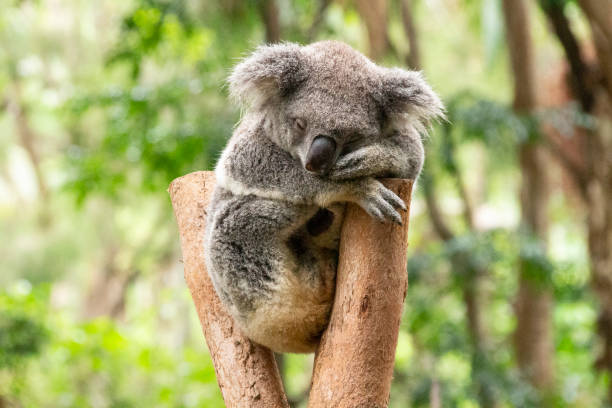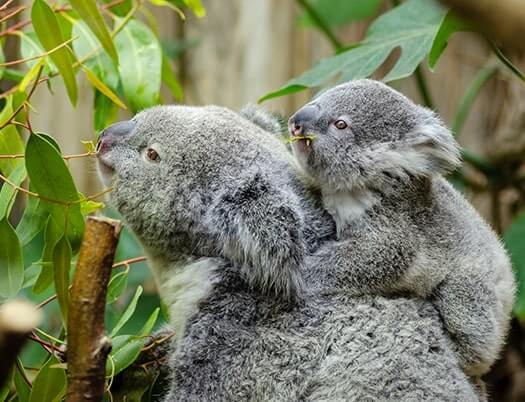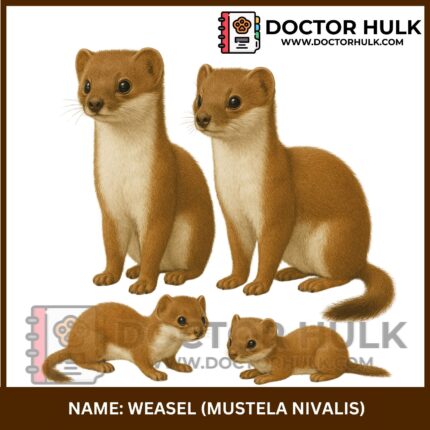The koala is a soft, furry animal that lives in trees and spends most of the day sleeping. Though many people think it’s a bear, the koala is not a bear at all, it’s a marsupial, meaning it carries its baby in a pouch. Koalas are calm, gentle, and love to eat leaves.
Scientific Classification
-
Kingdom: Animalia
-
Phylum: Chordata
-
Class: Mammalia
-
Infraclass: Marsupialia
-
Order: Diprotodontia
-
Family: Phascolarctidae
-
Genus: Phascolarctos
-
Species: Phascolarctos cinereus
Common Names
-
Koala
-
Koala Bear (incorrect but popular)
-
Eucalyptus Bear (due to their diet)
Geographic Distribution
Koalas are native to:
-
Eastern and Southern Australia
-
Mostly in states like Queensland, New South Wales, Victoria, and South Australia
They live in:
-
Eucalyptus forests
-
Woodlands with tall, leafy trees
-
Sometimes near towns and parks
 Image showing Koala resting in a eucalyptus tree (Source: iStock)
Image showing Koala resting in a eucalyptus tree (Source: iStock)
Physical Characteristics
-
Size: 60–85 cm long
-
Weight: 4–15 kg (males are heavier)
-
Fur: Thick, soft, grey or brown
-
Nose: Large, black, and leathery
-
Ears: Big and fluffy
-
Claws: Sharp for climbing trees
What do Koalas eat?
Koalas are herbivores and eat mainly:
-
Eucalyptus leaves (their favorite!)
-
Sometimes other tree leaves
Eucalyptus leaves are tough and not tasty to many animals, but koalas have a special stomach that helps them digest it. They eat for about 4 hours a day and sleep the rest.
How do Koalas raise babies?
-
A baby koala is called a joey.
-
It is born tiny and hairless, then crawls into the mother’s pouch.
-
Stays in the pouch for 6 to 7 months.
-
Later, it rides on the mother’s back and learns to eat leaves.
Fun facts about Koalas
-
Koalas sleep up to 20 hours a day to save energy.
-
Each koala has its own sound and smell, like a fingerprint.
-
Their nose helps them choose the best eucalyptus leaves.
-
Koalas have two thumbs on each front paw for better gripping.
-
A male koala has a loud call to mark his territory.
Importance to Humans
Positive Roles:
-
Loved as a national symbol of Australia
-
Attracts many tourists every year
-
Helps educate people about conservation
-
Featured in children’s books and cartoons
Challenges:
-
Many are injured in road accidents or bushfires
-
Can carry Chlamydia, which causes eye and reproductive issues
-
Loss of eucalyptus forests puts their lives at risk
Health & common issues
Koalas face several health and environmental threats, especially when living near cities.
Common health problems include the following:
-
Chlamydia infection – causes blindness and infertility
-
Koala retrovirus (KoRV) – weakens the immune system
-
Heat stress and dehydration
-
Injuries from dog attacks or car accidents
Veterinary care tips (for rescued koalas):
-
Special formula for young joeys
-
Clean wounds gently and monitor stress
-
Offer fresh eucalyptus daily
-
Keep environment calm and quiet
Conservation Status
-
Status: Vulnerable (on the IUCN Red List)
-
Koala numbers have dropped due to:
-
Habitat loss
-
Bushfires
-
Disease
-
Climate change
-
Koalas are protected by Australian law, and many groups are working to save them.
Koala vs Kangaroo
| Feature | Koala | Kangaroo |
|---|---|---|
| Movement | Climbs trees slowly | Hops with strong back legs |
| Habitat | Lives in trees | Lives on the ground |
| Diet | Eucalyptus leaves | Grass and plants |
| Sleep Time | Up to 20 hours a day | Less sleep, more grazing |
| Baby Care | Joey in pouch, rides on back | Joey in pouch, then hops out |

Image showing Koala mother carrying joey on her back under soft light (Source: Curumbin Wildlife Sanctuary)
If you need help with wild animal rescue or want to learn more about marsupials, you can visit Doctor Hulk Veterinary Hospital, or call 08143397614.













Reviews
There are no reviews yet.